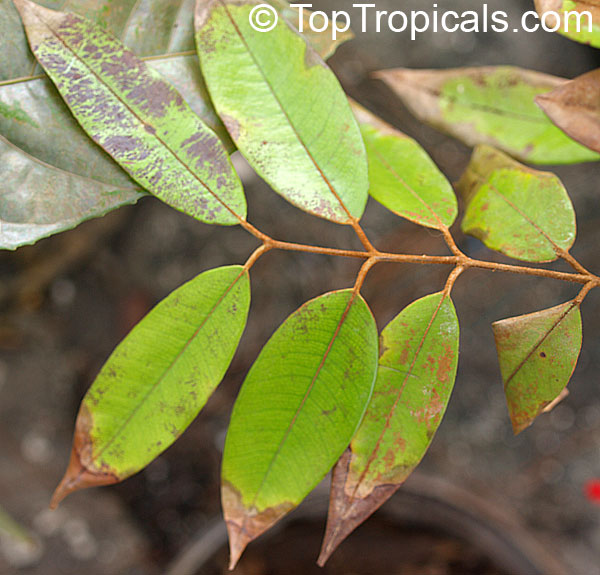Plinia edulis (Cambuca)
Top Tropicals Plant Encyclopedia
Botanical names: Plinia edulis, Marlierea edulis, Rubachia glomerata
Common names: Cambuca, Cambuca-Verdadeiro, Cambucaseiros
Family: Myrtaceae
Origin: Brazil








Cambuca is very little known fruit despite if its superior qualities. This fruit has well-balanced sweet-acid flavor, the soft texture, the medium fruit size, the high pulp content and the large fruit yield. However, it is an almost unknown fruit in the United States. Even in Brazil, there are very little people who know it. It was a very usual fruit at the Rio de Janeiro markets 60 years ago but today it disappeared due to devastation of its natural environment. Its name came from the Tupi Indian word kabuka, which means "The bud plant" (maybe due the cauliflower aspect).
Cambuca is a very slow growing, evergreen tree, reaching 15-20 ft high. The short trunk (30% of the total height), has a wide and dense crown of slender, spreading branches. As many other plants from its family, it has a smooth, thin, pale brownish-gray outer bark easily pealed off in large flakes to show the coppery layer below. Glossy, curled margin leaves, 2-4" long, 1-2" wide, dark green above and slightly downy, light green below. The white flowers, with a cluster of numerous stamens, are born agglomerated in groups (2-8 flowers) over the branches axils or distributed around the stem. The very smooth, short stalked, globular berry is larger than most Myrciaria and Eugenia. They are green at the beginning, turning yellow to bright orange-yellow when ripen, presenting many slightly raised longitudinal ridges. Some sources mention about the existence of fruits up to 4" large, but usually they are 1-2". Under the leathery, thin skin, there is a soft, grainless, juicy, orange-yellow, thick flesh, similar to Peaches in texture. It involves an incredibly delicious, translucent, melting, yellow pulp that encloses one two light purple seeds, easily separable from the pulp. Both, flesh and pulp, have a delicious, well balanced subacid to sweet flavor, resembling jaboticabas, grumichamas and pitombas, but without any trace of astringency or resinous aftertaste. Fully ripe cambucas are prized to eat out of hand. Cut around the middle of the fruit to reach its delicious, natural jelly like, internal pulp with a spoon. The external flesh may be used to make jams, marmalades and pies. Both are used to make juices and ice creams rich in flavor and color.
In its natural habitat, Cambuca grows in a very hot and rainy region. However, this plant can be very well adapted to many different climates. Well-established trees can tolerate as much as 2 months of drought without irrigation.
There is very little information about the existence of specimens growing outside Brazil. Even in subtropical areas, Cambuca showed to be cold hardy during the winter.
Cambuca prefers a deep, rich, well drained soil and full sun. It is a very slow growing plant. Trees 10 year old, are just 6-8 ft high. Young trees must be pruned to maintain the trunk cleaned up to about 2 ft.
The tree is very ornamental due to its dense canopy and the decorative effect when setting their fruits. Leaves and seed's decoction are used in homeopathic formulations against bronchitis and coughs. The astringent bark can be used in leather industry.

